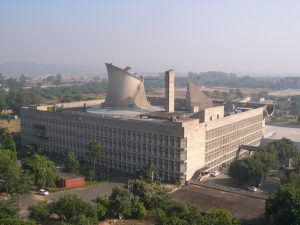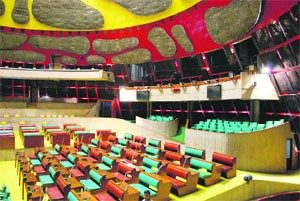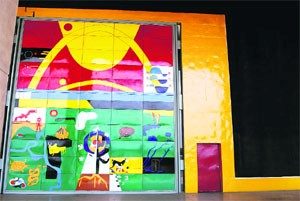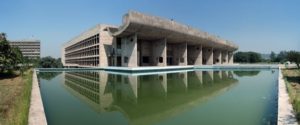The Capitol Complex of Chandigarh, one among 17 buildings of the Swiss-French architect Le Corbusier added to the World Heritage List in 2016, is an architectural wonder, incongruous to the era in which it was created. Conceptualized and built in the 1950s by Le Corbusier, it is a sprawling area that houses three buildings – the Legislative Assembly (or the Palace of Assembly), the Secretariat and the High Court. Seeming to spring from the pages of a popular Ayn Rand novel, the buildings are just the right amalgamation of eclectic and old-world grandeur that simply take one’s breath away.

The Capitol Complex is the crowning glory of the modern city of Chandigarh, built at the behest of then Prime Minister Jawaharlal Nehru, to stand as a symbol of the emergence of a modern, unfettered India, into a new era. The Capitol Complex is not exempt from Le Corbusier’s tenet-defying architectural designs. Of particular note is the Legislative Assembly, also known as the Palace of Assembly, which stands out due to its unique shape.
The Palace of Assembly is conceived as a rectilinear square with a monumental portico facing the main plaza. A band of offices are found on the opposite side of the building. The building has two parts, the assembly chamber (the Punjab assembly), and the smaller council chamber (the Haryana assembly). The Punjab assembly lies under a massive hyperbolic tower, extending above the roofline with a height of 124ft. at its highest point, and a diameter of 128ft. at its base. The Haryana assembly, conceived in a rectilinear frame, features a pyramidal roof at the top. The assemblies are linked by a foyer. The tower is reflective of the industrial cooling towers seen in factories, possibly inspired by the cooling chimneys that Le Corbusier saw everywhere in Ahmadabad, as well as his fascination with the Indian bulls. Some say that the symbols Le Corbusier uses in his structural elements are a reflection of the sun and the moon, which he thought would be a good modern guide for the deliberations of the politicians within.
The Legislative assembly is made with a hyperbolic shell with an average thickness of 15 cm, constant throughout the surface. This ensures low cost and a minimum of weight.
As one approaches the Palace of Assembly one is struck by what seems to be an unimaginative design, comprising of rows on rows of boxed windows. However, upon entering the building, the sheer grandeur and volume of the seemingly endless floor heights take one aback. One struggles to come to terms with the sheer scale of the structure in relation with one’s own smallness.
Le Corbusier has employed bricks and concrete with rough finishes, as these were the principal architectural materials easily available in Chandigarh. Steel and other material were rejected as they were scarce and not feasible for the vast project at hand. The sombre shades of the exposed reinforced concrete exterior give it a solemn aura befitting the serious function of the building. However, Le Corbusier’s play with bright primary colours, shapes and forms burst forth in the skylight and window cut-outs of different shapes. Staircases, lifts and ramps provide access to the different levels in the building, adding to the efficiency of ventilation and the illusion of height.

The assembly chamber, with a seating capacity of 252 persons, is a study in colour, with the hyperbolic paraboloid dome set within the pastel shades of green, yellow and pink of the three pylons. The colours are punctuated by sound-absorbing acoustic tiles on one level and cloud-like shapes looming upward towards the mirror-like dome. The riot of colours continues into the yellow carpets and the fixed green upholstered chairs that were specially designed by Le Corbusier’s team.
The Assembly building bursts more colour through the giant tapestries that adorn its walls, facades and doors. Each mural comprises of Le Corbusier’s signature tile-like arrangement of colours with symbols and motifs in contrasting shades. This includes an enamelled door painted by Corbusier himself, which appears at the entrance of the Assembly.

The front of the assembly hall faces a serene pool which is filled by rain water that collects in the trough-like feature above, and overflows at the higher end, into the pool. The trough also acts as a shade from the sunlight. This trough is held up by eight thin piers, standing at angles, which provide colour to the exterior, as well as improve ventilation, providing a cool respite from the heat outside. A unique feature of the building, as well as most of Le Corbusier’s other buildings, is the louvers ‘brise soleil’, which are featured on lateral walls for protection against the glare of the sun.

The Palace of Assembly shares features consistent with Le Corbusier’s other buildings, namely the brightly coloured façades, the trough-like element for rain water conservation, the use of thin pier-like columns, and the mathematical shapes that tower over the buildings, standing as a symbol of nature, cultural elements and Le Corbusier’s obsession with geometrical shapes and their relation to the cosmic.
Le Corbusier’s installations are progressively gaining recognition as representative of the heritage of modern man and his quest to exist in oneness with nature and science, and the Palace of Assembly of Chandigarh is a shining example of the same.

This is just beautiful. Chandigarh is one of the best city in the world designed with perfect Architectural Design. I am proud to be part of Chandigarh. Thanks for Sharing.